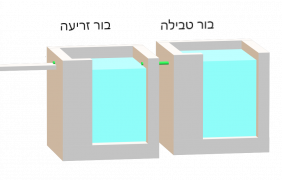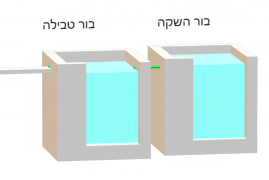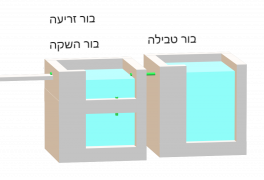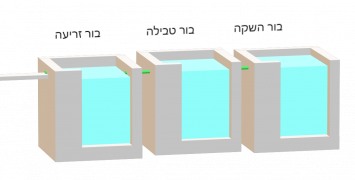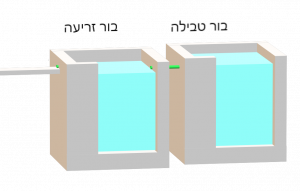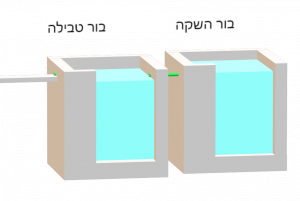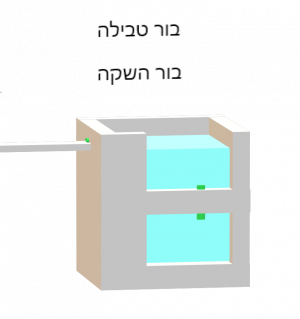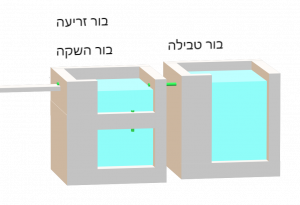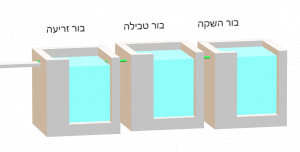Modern Mikvaot: Difference between revisions
From Halachipedia
(Created page with "== Diagrams of Modern Mikvaot == <gallery mode="packed-hover"> File:Mikva_two_borot_zeriya.png|Two borot (Chatom Sofer, Chazon Ish) File:Mikva_two_borot_hashaka.png|Two borot (Divrei Chayim) File:Mikva_three_borot_two_hashaka.png|Three Borot (Mishna Halachot, Klausenburger Rebbe) File:Bor_al_gabi_bor.png|Two Borot (Rashab, Chabad) File:Three_borot_bor_al_gabi_bor.png|Three borot (Satmer Rav) File:Three borot.png|Three Borot (Rav Moshe) </gallery>") |
|||
| Line 8: | Line 8: | ||
File:Three borot.png|Three Borot (Rav Moshe) | File:Three borot.png|Three Borot (Rav Moshe) | ||
</gallery> | </gallery> | ||
==Modern Mikvaot== | |||
=== Tap water === | |||
# The poskim discuss at great length whether the tap water is sheuvim. The conclusion is that they all hold that it is invalid and may not be used.<ref>Minchat Yitzchak 1:146 is machmir on city water. the factors to be lenient are: (1) the meters, pumps, and pipes were built to function while attached to the ground (Gidulei Tahara). (2) There's a connection between the water from the tap and the resouviour and that creates hashaka (Rashba). (3) Hamshacha on all of the water in the mikveh is only derabbanan (Maharsham). However, he disagrees with all of these factors because (1) Nodeh Beyehuda argues that it is still considered sheuvim even if it is built to be connected to the ground. (2) Rash and Rosh argue with that Rashba and Shulchan Aruch is strict. Also, Rashba isn't clear and is subject to a dispute between Bet Yosef and Maharitatz. (3) Imrei Yosher holds that hamshacha of all of the water on cement is pasul mideoritta. Shevet Halevi 2:103 also holds that the city water is sheuvim miderabbanan after there is hamshacha. Either way, he holds it is completely invalid and may not be used for a mikveh.</ref> | |||
=== Two borot using zeriya === | |||
[[Image:Mikva_two_borot_zeriya.png|right|300px|Two borot (Chatom Sofer, Chazon Ish)]] | |||
# Chatom Sofer 214 holds that the best way to make a mikveh is to use zeriya. The benefit is that hashaka with sheuvim is questionable (Tosfot Rid and Kesef Mishna) and zeriya is firmly established. Another positive is that there’s no question of fulfilling the opinion of [https://beta.hebrewbooks.org/reader/reader.aspx?sfid=11651#p=437&fitMode=fitwidth&hlts=&ocr= Rabbenu Yerucham (26:5 226a)] to have continuous hashaka. The downside of such an approach is natan seah vnatal seah (Rambam and Raavad against Rash and Rosh) and that is solved since there’s no obvious act of taking away water (Ramban, Bet Yosef). The Divrei Chaim disputes this point and shows that the Raavad would invalidate the mikveh because of natan seah vnatal seah even if it isn’t evident. Chazon Ish held you should just do zeriya. | |||
## Maharshag YD 65 defends Chatom Sofer about problems of natan seah vnatal seah. He suggests doing zeriya into pit two and spill over into tevilah pit then hashaka once with pristine hashaka bor. He says that the issue of natan seah doesn’t apply to the tevilah bor since the drawn water was added to the other pit and only overflowed there. | |||
## Mishna Halachot 10:146 said that zeriya in second pit is only effective if it is first still and then spilled over. Cheshev Sofer YD 13 said that was the minhag to do. | |||
## Satmer Rav in Divrei Yoel 69 said you can do zeriya with bor al gabi bor and have it overflow into bor tevilah. Mishna Halachot 10:146 said it is pasul since the katafras makes it not connected to a mikveh and zochlin is invalid for zeriya so both mikvehs become invalid. | |||
## Igrot Moshe YD 2:94 writes that you shouldn’t just do zeriya because of natan seah vnatal seah. In Igrot Moshe 1:112 he writes that it isn't really necessary to be concerned for the Raavad and so this is kosher technically speaking. | |||
=== Two borot using hashaka === | |||
[[File:Mikva_two_borot_hashaka.png|right|300px|Two borot (Divrei Chayim)]] | |||
# Divrei Chaim responsa CM 1:37 holds that the best way to make a mikveh is to use hashaka. The downside is that to fulfill Rabbenu Yerucham we need the hashaka pit always open and to avoid natan seah vnatal seah we need to refill the rainwater pit frequently so that there remains a pristine minimum of 21 seah of rainwater. Being that the longer the hole between the mikveh’s is open the more water that is transferred the sooner the rainwater needs to be changed. The solution is that the hole should be opened only once to create the hashaka and then close it up. That isn’t concerned for the Rabbenu Yerucham but it is concerned for the Rambam and Raavad of natan seah vnatal seah. | |||
## Rav Moshe (Igrot Moshe 1:112) writes that this mikveh is technically kosher and it isn't necessary to be strict for the Rabbenu Yerucham. | |||
## Igrot Moshe YD 2:94 approves of this type of mikveh to solve the issue for Rambam and Raavad since momentary hashaka works for natan seah vnatal seah. However, the Tzemech Tzedek 171 argues that this doesn’t actually solve the Rambam and Raavad either because they certainly would accept Rabbenu Yerucham as they fundamentally need the presence of 21 seah. [Problematically, the Divrei Chaim 201:20 himself makes the same point as the Tzemech Tzedek.] Because of this point, Rabbi Moshe Bick (Taharat Yom Tov 8:27) convinced the Satmer rebbe to hold like the Chabad mikveh. | |||
=== Three borot using hashaka === | |||
[[File:Mikva_three_borot_two_hashaka.png|right|300px|Three Borot (Mishna Halachot, Klausenburger Rebbe)]] | |||
# One to connect one time and one to keep open. Mishna Halachot 10:146 that’s the minhag of Ungar and Galisiya like divrei chayim with 3 pits. He answered the Tzemech Tzedek by saying that although the Raavad would agree with Rabbenu Yerucham that’s only for a mikveh made completely with drawn water but not for a mikveh that is just invalid because of natan seah vnatal seah. That can be fixed with a momentary hashaka. Maharshag 1:66 also rejected the Tzemech Tzedek’s equation. Igrot Moshe YD 2:94 would agree. | |||
## Divrei Yatziv YD 117 agrees that the minhag is to have 3 pits, one open all the time and one opened only momentarily. | |||
=== Bor al gabi bor === | |||
[[File:Bor_al_gabi_bor.png|right|300px|Two Borot (Rashab, Chabad)]] | |||
# Rashab (Pitchai Mikvaot 9:23 p. 327 cites the notes of the Rashab printed at the end of Shulchan Aruch Harav) holds that the best way to make a mikveh is to use a bor al gabi bor. The benefit is that it fulfills Rabbenu Yerucham and also natan seah vnatal seah because the transference of the water between the lower and upper mikveh is minimal. The Divrei Chaim 1:46 argued that the hashaka was invalid since it is considered katafras. Others argued that this was an incorrect explanation of katafras. Satmer Rebbe (packet 15 p24, Taharat Yom Tov 8:27) agrees with the Rashab that it is the best solution and having a hashaka bor is unnecessary. In practice the Satmer prefer bor al gabi bor min hasad (Divrei Yoel YD 80). | |||
## Imrei Yoshar 2:79 and Rav Moshe (Igrot Moshe YD 3:65) held that katafras is only with a pipe in which the water is moving and not two pits one on top of the other. Divrei Chayim 1:46 himself held it was an issue. | |||
## The Pitchei Mikvaot p. 327 quotes the Klozenberger that a mikveh on top of a mikveh is kosher if there’s also a hashaka on the side. He cites the Betzel Chachma who says that it wouldn’t help since once it is katafras you can’t connect to it but the Pitchei Mikvaot didn’t understand how having an extra hashaka could possibly ruin the mikvah. Minchat Yitzchak 6:90 questions such a mikveh. Rav Moshe Feinstein (Mesorat Moshe v. 2 p. 228) said that if there are some lubavitch in the area it is best to make a bor al gabi bor with another bor hashaka on the side to satisfy everyone. He said that he didn’t believe that anyone who invalidate it. | |||
## The Viznitzer Rebbe [https://cdn.yutorah.net/_materials/packet-15-525913.pdf (Obituaries, New York Times, March 16, 2012, p. B10)] held the best mikveh is one that is just rainwater and doesn't use any hashaka or zeriya with any tap water. | |||
=== Bor al gabi bor min hasad === | |||
[[File:Three_borot_bor_al_gabi_bor.png|right|300px|Three borot (Satmer Rav)]] | |||
# The Satmer Rav in Divrei Yoel 69 had another solution. He held you can have a bor hashaka with a divider. It is a bor al gabi bor min hasad. It is a continuous connection between the bor tevilah and bor hashaka, but there’s a third mikveh below and isn’t getting contaminated quickly. Chesed Yehoshua 2:57 agreed. | |||
## Chelkat Yakov held to do this with a tiny connection. Since the issue is only rabbinic then the hole doesn’t need to be a shifoferet hanod. That would mitigate the issue of natan seah vnatal seah. Teshuvot Vehanhagot didn’t like it because of zochlin. Shevet Halevi thought it isn’t zochlin. | |||
## Tzelemer Rav in Gedulot Merkachim YD 52 disapproved of the Satmer mikveh since it was katafras of the Divrei Chayim. It can be fixed if the top area independently has 40 seah. Mishna Halachot 10:146 s.v. haamnam quotes the Kloizenberger Rebbe who also disapproved of the bor al gabi bor min hasad because of katafras. In s.v. vdaah he writes that the bor al gabi bor on the side is invalid even if the top area has 40 seah since it is katafras and you can’t do any hashaka with katafras. Shevet Halevi says this is wrong because standing katafras isn’t pasul in hashaka. That’s a combination of wrong definitions. | |||
=== Three borot using hashaka and zeriya === | |||
[[File:Three borot.png|right|300px|Three Borot (Rav Moshe)]] | |||
#Rav Moshe (Igrot Moshe YD 1:112) writes that it is possible to satisfy all of the opinions by using a bor zeriya and bor hashaka. The tap water goes into the bor tevila and overflows into a bor tevila. That bor tevila has hashaka to the bor hashaka. Even though the Raavad would disapprove of the bor tevila since the original rainwater becomes depleted quickly, that is solved with the bor hashaka that is untouched and remains closed, besides one time after the bor tevila water is replaced. The reason for the bor zeriya is to fulfill the opinion of the Rabbenu Yerucham, who holds that the hashaka has to be continuous. Rav Moshe holds that this solution works for everyone since Rabbenu Yerucham cannot hold like the Raavad and vice versa. He also held that having more borot than this is just a waste of money. | |||
Revision as of 03:37, 17 October 2023
Diagrams of Modern Mikvaot
Modern Mikvaot
Tap water
- The poskim discuss at great length whether the tap water is sheuvim. The conclusion is that they all hold that it is invalid and may not be used.[1]
Two borot using zeriya
- Chatom Sofer 214 holds that the best way to make a mikveh is to use zeriya. The benefit is that hashaka with sheuvim is questionable (Tosfot Rid and Kesef Mishna) and zeriya is firmly established. Another positive is that there’s no question of fulfilling the opinion of Rabbenu Yerucham (26:5 226a) to have continuous hashaka. The downside of such an approach is natan seah vnatal seah (Rambam and Raavad against Rash and Rosh) and that is solved since there’s no obvious act of taking away water (Ramban, Bet Yosef). The Divrei Chaim disputes this point and shows that the Raavad would invalidate the mikveh because of natan seah vnatal seah even if it isn’t evident. Chazon Ish held you should just do zeriya.
- Maharshag YD 65 defends Chatom Sofer about problems of natan seah vnatal seah. He suggests doing zeriya into pit two and spill over into tevilah pit then hashaka once with pristine hashaka bor. He says that the issue of natan seah doesn’t apply to the tevilah bor since the drawn water was added to the other pit and only overflowed there.
- Mishna Halachot 10:146 said that zeriya in second pit is only effective if it is first still and then spilled over. Cheshev Sofer YD 13 said that was the minhag to do.
- Satmer Rav in Divrei Yoel 69 said you can do zeriya with bor al gabi bor and have it overflow into bor tevilah. Mishna Halachot 10:146 said it is pasul since the katafras makes it not connected to a mikveh and zochlin is invalid for zeriya so both mikvehs become invalid.
- Igrot Moshe YD 2:94 writes that you shouldn’t just do zeriya because of natan seah vnatal seah. In Igrot Moshe 1:112 he writes that it isn't really necessary to be concerned for the Raavad and so this is kosher technically speaking.
Two borot using hashaka
- Divrei Chaim responsa CM 1:37 holds that the best way to make a mikveh is to use hashaka. The downside is that to fulfill Rabbenu Yerucham we need the hashaka pit always open and to avoid natan seah vnatal seah we need to refill the rainwater pit frequently so that there remains a pristine minimum of 21 seah of rainwater. Being that the longer the hole between the mikveh’s is open the more water that is transferred the sooner the rainwater needs to be changed. The solution is that the hole should be opened only once to create the hashaka and then close it up. That isn’t concerned for the Rabbenu Yerucham but it is concerned for the Rambam and Raavad of natan seah vnatal seah.
- Rav Moshe (Igrot Moshe 1:112) writes that this mikveh is technically kosher and it isn't necessary to be strict for the Rabbenu Yerucham.
- Igrot Moshe YD 2:94 approves of this type of mikveh to solve the issue for Rambam and Raavad since momentary hashaka works for natan seah vnatal seah. However, the Tzemech Tzedek 171 argues that this doesn’t actually solve the Rambam and Raavad either because they certainly would accept Rabbenu Yerucham as they fundamentally need the presence of 21 seah. [Problematically, the Divrei Chaim 201:20 himself makes the same point as the Tzemech Tzedek.] Because of this point, Rabbi Moshe Bick (Taharat Yom Tov 8:27) convinced the Satmer rebbe to hold like the Chabad mikveh.
Three borot using hashaka
- One to connect one time and one to keep open. Mishna Halachot 10:146 that’s the minhag of Ungar and Galisiya like divrei chayim with 3 pits. He answered the Tzemech Tzedek by saying that although the Raavad would agree with Rabbenu Yerucham that’s only for a mikveh made completely with drawn water but not for a mikveh that is just invalid because of natan seah vnatal seah. That can be fixed with a momentary hashaka. Maharshag 1:66 also rejected the Tzemech Tzedek’s equation. Igrot Moshe YD 2:94 would agree.
- Divrei Yatziv YD 117 agrees that the minhag is to have 3 pits, one open all the time and one opened only momentarily.
Bor al gabi bor
- Rashab (Pitchai Mikvaot 9:23 p. 327 cites the notes of the Rashab printed at the end of Shulchan Aruch Harav) holds that the best way to make a mikveh is to use a bor al gabi bor. The benefit is that it fulfills Rabbenu Yerucham and also natan seah vnatal seah because the transference of the water between the lower and upper mikveh is minimal. The Divrei Chaim 1:46 argued that the hashaka was invalid since it is considered katafras. Others argued that this was an incorrect explanation of katafras. Satmer Rebbe (packet 15 p24, Taharat Yom Tov 8:27) agrees with the Rashab that it is the best solution and having a hashaka bor is unnecessary. In practice the Satmer prefer bor al gabi bor min hasad (Divrei Yoel YD 80).
- Imrei Yoshar 2:79 and Rav Moshe (Igrot Moshe YD 3:65) held that katafras is only with a pipe in which the water is moving and not two pits one on top of the other. Divrei Chayim 1:46 himself held it was an issue.
- The Pitchei Mikvaot p. 327 quotes the Klozenberger that a mikveh on top of a mikveh is kosher if there’s also a hashaka on the side. He cites the Betzel Chachma who says that it wouldn’t help since once it is katafras you can’t connect to it but the Pitchei Mikvaot didn’t understand how having an extra hashaka could possibly ruin the mikvah. Minchat Yitzchak 6:90 questions such a mikveh. Rav Moshe Feinstein (Mesorat Moshe v. 2 p. 228) said that if there are some lubavitch in the area it is best to make a bor al gabi bor with another bor hashaka on the side to satisfy everyone. He said that he didn’t believe that anyone who invalidate it.
- The Viznitzer Rebbe (Obituaries, New York Times, March 16, 2012, p. B10) held the best mikveh is one that is just rainwater and doesn't use any hashaka or zeriya with any tap water.
Bor al gabi bor min hasad
- The Satmer Rav in Divrei Yoel 69 had another solution. He held you can have a bor hashaka with a divider. It is a bor al gabi bor min hasad. It is a continuous connection between the bor tevilah and bor hashaka, but there’s a third mikveh below and isn’t getting contaminated quickly. Chesed Yehoshua 2:57 agreed.
- Chelkat Yakov held to do this with a tiny connection. Since the issue is only rabbinic then the hole doesn’t need to be a shifoferet hanod. That would mitigate the issue of natan seah vnatal seah. Teshuvot Vehanhagot didn’t like it because of zochlin. Shevet Halevi thought it isn’t zochlin.
- Tzelemer Rav in Gedulot Merkachim YD 52 disapproved of the Satmer mikveh since it was katafras of the Divrei Chayim. It can be fixed if the top area independently has 40 seah. Mishna Halachot 10:146 s.v. haamnam quotes the Kloizenberger Rebbe who also disapproved of the bor al gabi bor min hasad because of katafras. In s.v. vdaah he writes that the bor al gabi bor on the side is invalid even if the top area has 40 seah since it is katafras and you can’t do any hashaka with katafras. Shevet Halevi says this is wrong because standing katafras isn’t pasul in hashaka. That’s a combination of wrong definitions.
Three borot using hashaka and zeriya
- Rav Moshe (Igrot Moshe YD 1:112) writes that it is possible to satisfy all of the opinions by using a bor zeriya and bor hashaka. The tap water goes into the bor tevila and overflows into a bor tevila. That bor tevila has hashaka to the bor hashaka. Even though the Raavad would disapprove of the bor tevila since the original rainwater becomes depleted quickly, that is solved with the bor hashaka that is untouched and remains closed, besides one time after the bor tevila water is replaced. The reason for the bor zeriya is to fulfill the opinion of the Rabbenu Yerucham, who holds that the hashaka has to be continuous. Rav Moshe holds that this solution works for everyone since Rabbenu Yerucham cannot hold like the Raavad and vice versa. He also held that having more borot than this is just a waste of money.
- ↑ Minchat Yitzchak 1:146 is machmir on city water. the factors to be lenient are: (1) the meters, pumps, and pipes were built to function while attached to the ground (Gidulei Tahara). (2) There's a connection between the water from the tap and the resouviour and that creates hashaka (Rashba). (3) Hamshacha on all of the water in the mikveh is only derabbanan (Maharsham). However, he disagrees with all of these factors because (1) Nodeh Beyehuda argues that it is still considered sheuvim even if it is built to be connected to the ground. (2) Rash and Rosh argue with that Rashba and Shulchan Aruch is strict. Also, Rashba isn't clear and is subject to a dispute between Bet Yosef and Maharitatz. (3) Imrei Yosher holds that hamshacha of all of the water on cement is pasul mideoritta. Shevet Halevi 2:103 also holds that the city water is sheuvim miderabbanan after there is hamshacha. Either way, he holds it is completely invalid and may not be used for a mikveh.
